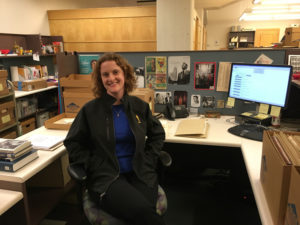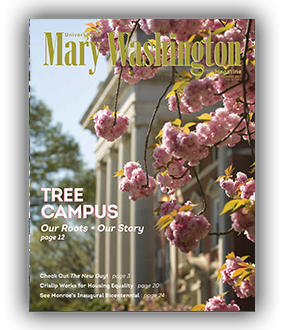
Archivist Clare Denk at her desk at the Academy of Motion Picture Arts and Sciences. (Photo by Marisa Duron)
By Edie Gross
Sturdy cardboard boxes arrive on Clare Denk’s desk bearing jumbles of dog-eared manuscripts, publicity photographs and candid snapshots, hand-written fan letters and personal correspondence.
Denk ’03, an archivist at the Academy of Motion Picture Arts and Sciences, meticulously sorts and catalogs collections of personal effects for the Academy’s Margaret Herrick Library in Beverly Hills, where students, scholars, and historians from around the world can access them.
“It never really gets boring because you move from one person’s life to another,” said Denk, who has worked at the Academy for seven years. “It never becomes repetitive.”
While combing through the donated keepsakes of Hollywood icons and behind-the-scenes crew members, Denk keeps an eye out for the unexpected. For instance, actress Bette Davis had a reputation for being no-nonsense, but she also drew smiley faces in her letters to Now, Voyager co-star Paul Henreid.
And long before Linwood Dunn was a special effects pioneer, with films like 1933’s King Kong and 1941’s Citizen Kane under his belt, he was a 14-year-old movie buff who created a handwritten spreadsheet listing each theater he’d gone to, the date, what film was playing, and whether it deserved a grade of poor, fair, good, or great.
“It was so endearing to see his burgeoning interest,” said Denk, who found the list among Dunn’s papers. “I love the personal discoveries.”
Not surprisingly, it was the historic preservation program that attracted Denk, who grew up in Northern Virginia, to Mary Washington.
“I was such a nerd, too. I always wanted to live in the oldest dorms because they were the most historic,” said Denk, who lived in Virginia and Ball halls while earning degrees in historic preservation and American studies. As a member of the Historic Preservation Club, she participated in the annual Ghost Walk, playing the role of a drunken cook responsible for accidentally burning down half of Fredericksburg in the 1800s.
She interned at the Library of Congress’ Prints & Photographs Division for two summers while in college, and after graduation, worked for a year at the American Folklife Center, cataloging manuscripts, photos, and oral histories for the Veterans History Project. A film buff, she was accepted into graduate school at UCLA, where in 2006 she earned a master’s degree in moving image archive studies, an interdisciplinary program between the film and library schools.
She worked for several years at the Getty Research Institute, registering incoming rare books, lithographs, drawings, and photos for its special collections department. Her dream, however, was to work for the Academy’s library, which she toured during grad school. Then she saw an opening for a cataloguer in the library’s special collections department.
“I wrote the most passionate cover letter I could think of and reworked it and reworked it. I never wanted a job so badly in my life,” said Denk, who has been there ever since.
Most of the collections she archives arrive in about 25 boxes. It took nearly 100 boxes, however, to hold the papers of Gregory Peck, perhaps best known for his Academy Award-winning role as Atticus Finch in To Kill a Mockingbird. Denk acknowledges that you’ve got to be invested in film history to properly inventory a collection that large. What does she do after spending just shy of two years cataloging one man’s ephemera?
“I take a deep breath, and I get really excited about starting on someone completely new.”
